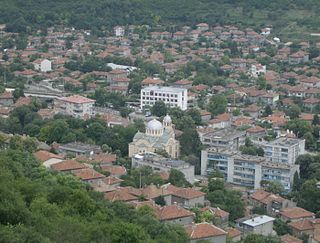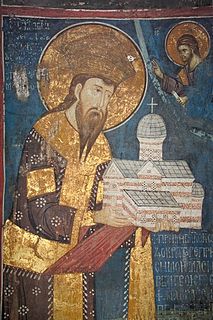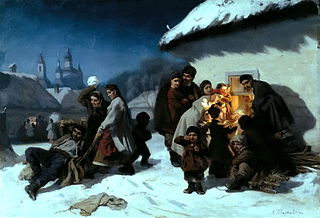
Dubrovnik, historically known as Ragusa, is a city on the Adriatic Sea in the region of Dalmatia, in the southeastern semi-exclave of Croatia. It is one of the most prominent tourist destinations in the Mediterranean, a seaport and the centre of the Dubrovnik-Neretva County. Its total population is 42,615. In 1979, the city of Dubrovnik was added to the UNESCO list of World Heritage Sites in recognition of its outstanding medieval architecture and fortified old town.

Stefan Uroš I, known as Uroš the Great was the King of Serbia from 1243 to 1276, succeeding his brother Stefan Vladislav. He was one of the most important rulers in Serbian history.

Ston is a settlement and a municipality in the Dubrovnik-Neretva County of Croatia, located at the south of isthmus of the Pelješac peninsula.

Pelješac is a peninsula in southern Dalmatia in Croatia. The peninsula is part of the Dubrovnik-Neretva County and is the second largest peninsula in Croatia. From the isthmus that begins at Ston, to the top of Cape Lovišta, it is 65 km or 40 mi long.
Dubrovnik Airline Limited was a Croatian charter airline, based in Dubrovnik, Croatia. It operated tourist charter flights from Europe and Israel to holiday destinations in Croatia. Its main base was Dubrovnik Airport.

Provadia is a town in northeastern Bulgaria, part of Varna Province, located in a deep karst gorge along the Provadiya River not far from the Bulgarian Black Sea Coast. It is the administrative centre of Provadia Municipality. As of December 2009, the town has a population of 12,901 inhabitants.

Stefan Uroš III, known as Stefan Dečanski, was the King of Serbia from 6 January 1322 to 8 September 1331. Dečanski was the son of King Stefan Milutin. He defeated two other pretenders to the Serbian throne. Stefan is known as Dečanski after the great Monastery of Visoki Dečani he built.

Ivan Stefan ruled as emperor (tsar) of Bulgaria for eight months from 1330 to 1331. He was the eldest son of emperor Michael III Shishman and Anna Neda of Serbia, a daughter of King Stefan Uroš II Milutin of Serbia. Ivan Stephen was a descendant of the Terter dynasty, the Asen dynasty and the Shishman dynasty. After his father's ascension to the throne in 1323 Ivan Stefan was associated as co-emperor. When Michael III Shishman divorced Anna Neda to marry Theodora Palaiologina, the daughter of Byzantine emperor Michael IX Palaiologos, in 1324, Ivan Stefan was exiled along with his mother and brother in a monastery. In the summer of 1330 he became emperor of Bulgaria with the help of his uncle Stephen Dečanski. After he was deposed in a coup d'état by the Tarnovo nobility, he fled along with Anna Neda in the domains of his father's brother Belaur in Niš and later to Dubrovnik. He was later expelled from there by Stephen Dušan under the pressure of Ivan Alexander. Ivan Stefan probably died in Naples.

The Republic of Ragusa was an aristocratic maritime republic centered on the city of Dubrovnik in South Dalmatia that carried that name from 1358 until 1808. It reached its commercial peak in the 15th and the 16th centuries, before being conquered by Napoleon's French Empire and formally annexed by the Napoleonic Kingdom of Italy in 1808. It had a population of about 30,000 people, of whom 5,000 lived within the city walls. Its motto was "Non bene pro toto libertas venditur auro", which means "Liberty is not sold for all the gold in the world".

Cavtat is a village in the Dubrovnik-Neretva County of Croatia. It is on the Adriatic Sea coast 15 kilometres south of Dubrovnik and is the centre of the Konavle municipality.

Dubrovnik Airport, also referred to as Čilipi Airport, is the international airport of Dubrovnik, Croatia. The airport is located approximately 15.5 km (9.5 mi) from Dubrovnik city centre, near Čilipi. It was the third-busiest airport in Croatia in 2019 after Zagreb Airport and Split Airport in terms of passenger throughput. It also has the country's longest runway, allowing it to accommodate heavy long-haul aircraft. The airport is a major destination for leisure flights during the European summer holiday season.

Dubrovnik was a flotilla leader built for the Royal Yugoslav Navy by Yarrow Shipbuilders in Glasgow in 1930 and 1931. She was one of the largest destroyers of her time. Resembling contemporary British designs, Dubrovnik was a fast ship with a main armament of four Czechoslovak-built Škoda 140 mm (5.5 in) guns in single mounts. She was intended to be the first of three flotilla leaders built for Yugoslavia, but was the only one completed. During her service with the Royal Yugoslav Navy, Dubrovnik undertook several peacetime cruises through the Mediterranean, the Turkish Straits and the Black Sea. In October 1934, she conveyed King Alexander to France for a state visit, and carried his body back to Yugoslavia following his assassination in Marseille.
Zagore, also Zagorie (Загорие), Zagora (Загора), or Zagoriya (Загория), was a vaguely defined medieval region in what is now Bulgaria. Its name is of Slavic origin and means "beyond [i.e. south of] the [Balkan] mountains". The region was first mentioned as Ζαγόρια in Greek when it was ceded to the First Bulgarian Empire by the Byzantine Empire during the rule of Tervel of Bulgaria in the very beginning of the 8th century. From the context, Zagore can be defined as a region in northeastern Thrace.

The medieval Bulgarian royal charters are some of the few surviving secular documents of the Second Bulgarian Empire, and were issued by five tsars roughly between 1230 and 1380. The charters are written in Middle Bulgarian using the Early Cyrillic alphabet.

Koliada or koleda is the traditional Slavic name for the period from Christmas to Epiphany or, more generally, to Slavic Christmas-related rituals, some dating to pre-Christian times. It represents a festival or holiday, celebrated at the end of December to honor the sun during the winter solstice. It also involves groups of singers who visit houses to sing carols.
Epidaurus or Epidauros was an ancient Greek colony founded sometime in the 6th century BC, renamed to Epidaurum during Roman rule in 228 BC, when it was part of the province of Illyricum, later Dalmatia. It is located at the modern-day Cavtat in Croatia, 15 km (9 mi) south of Dubrovnik.
Lujo Vojnović was a Serbian writer, politician, and diplomat from Dubrovnik. His older brother was Ivo Vojnović, the dramatist and poet.

The Charter of Ban Kulin was a trade agreement between the Banate of Bosnia and the Republic of Ragusa that effectively regulated Ragusan trade rights in Bosnia, written on 29 August 1189. It is one of the oldest written state documents in the region.














